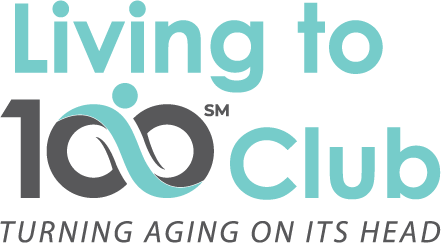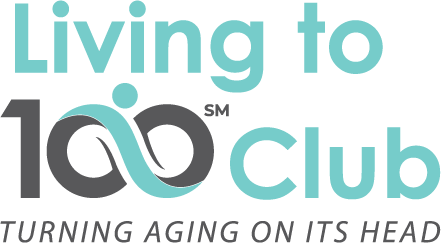Joe Casciani, PhD
It’s a New Year! And, it’s a new Decade! Here at the Living to 100 Club, we believe we should adopt a longer view, since we are living longer.
Are you ready to take control of your life, turn aging on its head, and make the best of every year? Physical activity and exercise are part of it.
You are in control of your health, actions, and attitudes. 75% of your longevity is controllable by things like diet, physical activity, sense of purpose, social networks, and smoking and alcohol use. 75%! Only 25% is due to genetics.
So, wouldn’t it make sense to learn more about the health habits of those who are in their 90’s and 100’s as a way to shape our own and adopt what we can of those who are aging successfully?
In this article we take a look at physical activity and exercise as one of these controllable factors, from a few different perspectives.
Exercise is good, but longevity doesn’t require marathons.
Centenarians do not typically run marathons; without generalizing, their physical activity tends to be incidental to improving fitness.
Exercise is intentional and planned, often structured, repetitive, and purposeful, and it is encouraged.
However, we know that many older adults, such as those centenarians identified in the Blue Zones, do not exercise, per se. But yet, they are physically very active throughout their day. They walk to stores, climb several flights of stairs, farm, maintain vegetable gardens, and a host of manual labors.
This physical activity, one of the ingredients of a successful aging recipe, encompasses more than exercise.
Physical activity is defined as any bodily movement produced by skeletal muscles that requires energy expenditure. It can include deliberate exercise, It can also include walking, working, gardening, cleaning, and other types of bodily movement.
You can make living an active, engaged, and physical experience.
And you can also set aside time in your day for exercise. Set a goal of maintaining or improving your physical well-being. One of the simplest forms of exercise is walking. With technology devices like a smart phone or step counter, it is easy to monitor how many steps taken each day. The recommended goal is 10,000 steps per day. Anything below 5,000 is considered sedentary. As a side note, a new book by Daniel Lieberman, Exercised: Why Something We Never Evolved to Do is Health and Rewarding, argues that humans evolved to limit our physical activity whenever we reasonably could. Conceivably, this could even extend to the industrialization of society. Consider how many inventions over the past 150 years have allowed us to move less, exert less effort, and become more sedentary. The forces seem to be working against us.
Recommendations on Physical Activity and Exercise
Let me offer you the recommendations from the World Health Organization for all adults. Items 4 and 6 specifically target the 65+ age group:
- At least 150 minutes of moderate intensity aerobic activity. Or at least 75 minutes of vigorous intensity aerobic activity throughout the week.
- Aerobic activity should be in bouts of at least 10 minutes duration.
- For additional benefits, the 150 minutes should be increased to 300 minutes. And the 75 minutes should be increased to 150 minutes per week.
- Those with poor mobility should perform physical activity to enhance balance and prevent falls 3 or more days a week
- Muscle strengthening activities should be performed involving major muscle groups 2 or more days per week.
- Some are unable to follow these recommendations due to health conditions. Adults in this age group should be as physically active and their ability and conditions allow.
Age is No Barrier to Successful Weight Loss
It’s never too late to lose weight and improve your health. Two hospitals in England have put to rest the myth that older adults can’t effectively lose weight.
Their research on weight loss in older adults found that obese people over the age of 60 can lose the same weight as younger people. The authors state that their results should clear up some myths about the benefits of older adults trying to lose weight. Over a 15-year period, 242 morbidly obese patients in two age clusters (under 60 and over 60) were monitored following their participation in weight loss programs. The programs focused on dietary changes, psychological support, and physical activity encouragement. At the end of the study, the weight decreases were consistent in both age groups.
The lead author, Dr. Thomas Barber maintained that weight loss in later years is more important because of the serious co-morbidities of obesity. He says that people who discount weight loss in older adults because of an ageist attitude put up barriers to lifestyle management of obesity. As he says, Age per se should not contribute to clinical decisions regarding the implementation of older adults’ lifestyle management.
What Works when Making Fitness a Habit?
Consistency, small steps, small rewards, and expanding your options are proven ways to harness “the power of habit.” Jim Owen, a former podcast guest, offers this advice in this recent article. Jim is also the creator of the documentary film, The Art of Aging Well. He offers down-to-earth approaches for making fitness a regular part of our day. He outlines the steps that lead to successfully making fitness a habit. Moving beyond the notion that willpower is all it takes. Willpower is temporary and fleeting, the author says. You must develop “the power of habit.”
We know that adopting any behavior change is difficult. Even with the best New Year’s resolutions and most sincere intentions, implementing new behaviors, like physical exercise is a challenge. To help with your goals for the New Year, try Jim’s quick read on for size. It will fit.
Closing
The Living to 100 Club community is here to support you in the New Year. We want to help you create a mindset to do what it takes to live to 100 and to stay positive on this journey. And we encourage you to keep in mind all of the things that are under your control.
Setting goals for the New Year are important for everyone. Increased physical activity should be one of your goals. We see over and over the benefits of higher physical activity and how this impacts our mental and physical health. See this article, for example, published in CancerNetwork, on how physical activity and decreased sitting improves health in older adults, with and without cancer. This is well-established science. We encourage you to embrace it.


